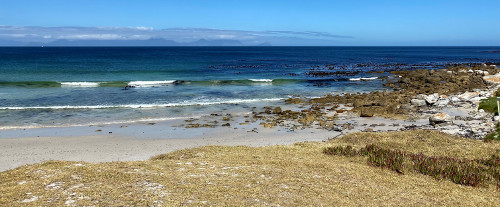
The Law of the Sea
The 1982 United Nations Convention on the Law of the Sea (LOSC) lays out the framework for the use and protection of the ocean. However, like most subjects of international law, the LOSC is quite complex. The complexity is exacerbated by questions of applicability, jurisdiction, and its inextricable link to other subjects of international law, such as environmental law, human rights law, labour law, criminal law, and marine spatial planning law, to name a few. Some States, especially in Africa, have yet to develop comprehensive marine law regimes to apply the provisions of the LOSC. Questions of State practice are central in the development of the law of the sea and its impact on access, safety at sea, exploitation, and protection of the marine environment. Amongst other things, Dr Denning Metuge’s research critically examines State practices across the African continent to establish whether these States have the requisite legal arsenal to enjoy their rights and obligations over the marine environment fully.
Marine Spatial Planning Law
Poor management of the marine environment and its resources over the years has exacerbated pressures upon the environment. It is imperative that identified and potential conflicts between the natural environment and human interventions be managed in a sustainable manner. A tool to resolve conflicting uses of the marine environment is marine spatial planning (MSP). MSP is employed to manage temporal and spatial access and uses of the marine environment with the aim of promoting sustainability and resilience. There has been a global push to attain the implementation phase of MSP, and it is expected that a third of the world’s exclusive economic zones will be governed within the framework of approved marine area plans by 2030. Denning's work also aims to contribute towards the development of policies and legal regimes for MSP in South Africa and other African states. With regard to South Africa, his work has identified potential regulatory conflicts that may stall the implementation of MSP in South Africa. Not only does Dr Denning Metuge discuss and recommend critical legislative changes that will avert conflict, but he also considers the consistency of the MSP legislation with the Constitution of the Republic of South Africa, 1996, which renders an environment not harmful to health or well-being a human right. At the continental level, Denning’s work informs on some essential elements that must be considered in the development of MSP legislation.
Some of Dr Denning Metuge’s ongoing projects include the UNEP-funded Development of Integrated, Ecosystem-based Land-Sea planning guidelines and Support for the Kenyan MSP Process. Dr Denning Metuge leads the delivery of an assessment report on the regulatory standards set out in Kenya’s Draft National Marine Spatial Framework, including best practices and challenges, as well as the delivery of a policy brief to inform the development of land-sea planning guidelines. This work is undertaken in collaboration with a transdisciplinary team of researchers from the Institute of Coastal and Marine Research at Nelson Mandela University. Dr Denning Metuge is also involved in the WWF-funded Analysis and study for the design of a regional vision, roadmap and technical guideline aimed at supporting the implementation of MSP in the Northern Mozambique Channel (NMC) area. Moreover, Dr Denning Metuge is also involved in a WildTrust-funded project on Small-Scale Fishers (SSF) and Marine Protected Areas in South Africa. This project is aimed at improving the management and sustainability of SSF in South Africa while generating working examples of positive relationships between marine protected areas (MPAs) and the most vulnerable rural fishers living within or adjacent to MPAs. Furthermore, Dr Denning Metuge is completing chapter contributions to volumes of the book project entitled The Law of the Sea: Contemporary Norms and Practice in Africa.
Climate Change: Legal and Governance Responses
Climate change is one of the most pressing socio-ecological and human rights issues of our time. The causes and impacts of climate change are unevenly distributed, raising issues of justice, particularly for those in the Global South who are least responsible for the problem, but worst affected by it. Against this backdrop, Dr Melanie Murcott engages in cutting-edge research on climate change law and governance issues. Her research spans environmental constitutionalism as a response to climate change, the role of the Sustainable Development Goals (SDGs) in addressing intersecting socio-ecological and justice issues, the global phenomenon of climate litigation, and the transnational dimensions of legal responses to climate change.
Melanie is currently engaged in several ongoing research projects to produce new knowledge in response to the pressing justice implications of climate change. These include a DOIS Global Minds project funded through Hasselt University in Belgium, titled ‘SDG Governance’, which she runs in collaboration with Dr Matteo Fermeglia at the University of Amsterdam, Netherlands to develop new, comparative knowledge on how the SDGs are informing governance responses to climate change in specific African and European contexts. In addition, Melanie runs a Global Network for the Study of Human Rights and the Environment project titled ‘Climate Litigation in the Global South’ in collaboration with Dr Maria Antonia Tigre at the Sabin Centre for Climate Change Law of Columbia Law School, USA. This project is currently supported by funding awarded to Melanie from the World Universities Network. Melanie, Maria Antonia, and their co-editor, Susan Ann Samuel of University of Leeds are funded to develop an edited volume titled Climate Litigation and Vulnerabilities: Global South Perspectives, as well as several other research outputs and a major grant application in collaboration with a global team of scholars. Further, Melanie and Dr Myriam Gicquello of Newcastle University, UK, are co-editing a multi-disciplinary volume titled Adjudicating Climate Change: Exploring Extra Legal Factors. This volume will engage with various factors beyond the law that influence the adjudication of climate disputes. It will feature contributions by experts in various disciplines from around the world and is to be published by Bloomsbury in their series, Global Challenges in Environmental Humanities.
Animal Law

The field of animal law is yet to emerge in South Africa. Yet, humanity’s relationships with the farmed, domesticated, and so-called ‘wild’ animals with whom we share the planet are complex and have far-reaching implications for Earth systems functioning. These relationships are governed by a range of legal, policy, and other mechanisms. Animals are largely left highly vulnerable to human hubris under these mechanisms. In other parts of the world, the field of animal law has developed and is evolving to advance more humane and environmentally sound relationships among humans and other animals. The Constitutional Court of South Africa has supported a more caring attitude towards animals and indicated that constitutional protection of the environment includes the protection of animals, given their intrinsic worth and sentience. To advance the field of animal law in South Africa, Dr Melanie Murcott is engaged in an ongoing research project with Amy P. Wilson with support from Animal Law Reform South Africa and in collaboration with a number of emerging and established experts in the field from South Africa and beyond. They are presently co-editing the first book on animal law in Africa titled Animal Law and Welfare in South Africa. The book is expected to be published by Routledge early in 2025.
Biodiversity, Protected Areas, and Land-Use Regulation
The importance of conserving, promoting the sustainable use, and equitable sharing of benefits derived from the use of biodiversity have been acknowledged for decades. Several recent reports have clearly illustrated the failure of international, regional, and domestic governance arrangements to forge workable and equitable solutions to achieve these three vital imperatives. Prof. Alexander (Sandy) Paterson’s research on biodiversity, protected areas and land-use regulation over the past two decades has sought to understand and in a small way resolve these governance challenges through focussing on a range of legal issues including: the development of global guidelines on protected areas law and connectivity conservation; regulating alien invasive species; bridging the gap between land reform and conservation through communally conserved areas; protecting the land and resources rights of indigenous peoples and local communities; understanding co-management arrangements; regulating mining activities in protected areas; formulating viable incentive-based conservation measures; and exploring the role of EIA as a tool to manage competing land-use interests. His most recent research fixation in this broad area is on how to manage conservation and strategic infrastructure priorities, especially where they come into direct conflict. This intrigue has been triggered by recent moves by the South African Government to introduce a range of legal reforms aimed at fast-tracking or exempting large-scale infrastructure projects (such as electricity distribution and transmission lines, substations, battery storage facilities, gas pipelines and certain types of renewable energy infrastructure) from rigorous EIA and approval processes. While the legal reforms are targeted at identified strategic corridors and zones, these concerningly overlap areas mapped as high conservation value and earmarked for future inclusion in protected areas and other effective conservation measures.
Other Effective Area-Based Conservation Measures
Area-based conservation initiatives have historically been a key component of international and domestic efforts to conserve biodiversity and promote climate mitigation and adaptation. Significant strides have been made over the past decade to expand the coverage, effectiveness, and equitable management of these initiatives, fuelled by temporal global commitments and targets made by parties to the Convention on Biological Diversity (CBD), most recently in November 2022 through the adoption of the Kunming-Montreal Global Biodiversity Framework. However, these strides have been skewed in favour of protected areas with other effective area-based conservation measures (OECMs) largely playing second fiddle. Recent international efforts to define what are OECMs, develop guidelines to clarify their form and nature, and facilitate their implementation have largely been driven by scientists. However, many of the elements and criteria underpinning OECMs are founded in or influenced by law. Prof. Alexander (Sandy) Paterson’s current research seeks to work with global and local scholars, policymakers, and conservationists to improve their understanding of the important role and influence of law, with a view to ensuring that any future reliance on OECMs achieves positive and sustained long-term outcomes for the in-situ conservation of biodiversity.

